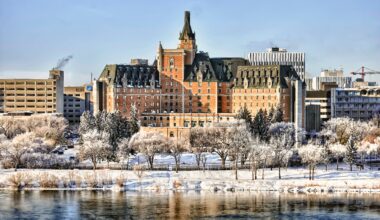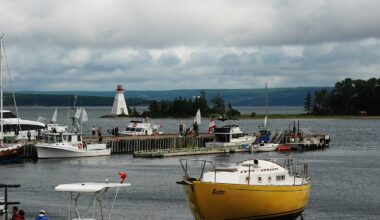Stand at Signal Hill in St. John’s and look east, there’s nothing but ocean between you and Ireland. You’re at North America’s edge, where the continent meets the Atlantic in a collision of land, sea, and sky so dramatic it takes your breath away.
This is Newfoundland and Labrador, Canada’s youngest province and perhaps its most distinctive. Where else can you witness 10,000-year-old icebergs drift past coastal villages? Where else do whales feed just meters from shore while musicians create kitchen parties that last until dawn? Where else does the landscape shift from sub-Arctic tundra to temperate coastlines within the same province?
Newfoundland and Labrador isn’t for everyone – let’s be honest about that from the start. This is a place that demands appreciation for rugged beauty, respect for maritime traditions, and adaptation to unique rhythms of life. But for those who understand its character, this province offers something increasingly rare: authentic experiences in landscapes that remain largely unchanged by development.
Welcome to the Rock, where being “from away” quickly transforms into being “one of us” if you’re willing to embrace what makes this place so unforgettably unique.
The Land That Time Forgot: Geography at Its Most Dramatic
 Newfoundland and Labrador’s geography creates some of North America’s most spectacular and challenging environments:
Newfoundland and Labrador’s geography creates some of North America’s most spectacular and challenging environments:
Island vs. Mainland: Two Distinct Regions
The province actually encompasses two very different areas:
Newfoundland Island
- 108,860 square kilometers of rugged terrain surrounded by ocean
- Coastline so convoluted it measures over 17,000 kilometers
- Interior featuring pristine lakes, rivers, and forests
- Sub-Arctic climate moderated by ocean influence
- Population concentrated in coastal communities
Labrador
- 294,330 square kilometers of continental wilderness
- Shares borders with Quebec and Nunavut
- Contains the Torngat Mountains and vast sub-Arctic landscapes
- Extremely sparse population with most residents in coastal communities
- Resource-rich territory with mining and hydroelectric development
These two regions offer completely different experiences while sharing provincial identity.
Coastal Drama
The meeting of land and sea creates extraordinary landscapes:
The Avalon Peninsula
- Most densely populated region including St. John’s
- Dramatic cliffs, hidden coves, and historic settlements
- Cape Spear: North America’s easternmost point
- Witless Bay Ecological Reserve protecting seabird colonies
- Historic sites from European exploration and settlement
The Great Northern Peninsula
- Gros Morne National Park: UNESCO World Heritage Site
- L’Anse aux Meadows: confirmed Viking settlement site
- Dramatic fjords and ancient mountain landscapes
- Traditional fishing communities maintaining historical character
The South Coast
- Isolated communities accessible only by boat or aircraft
- Traditional outport culture preserved by geographic isolation
- Spectacular coastal scenery with minimal development
- Authentic Newfoundland culture and dialect maintained
Interior Wilderness
Beyond the coasts, vast wilderness areas remain largely untouched:
- Terra Nova National Park protecting boreal forest ecosystems
- Hundreds of pristine lakes and rivers ideal for fishing and paddling
- Caribou herds migrating across tundra landscapes
- Old-growth forests in isolated river valleys
- Minimal human impact preserving natural ecosystems
This geographic isolation and natural preservation create opportunities for authentic wilderness experiences increasingly rare elsewhere.
St. John’s: North America’s Most Distinctive City
St. John’s deserves special attention as one of North America’s most unique urban experiences:
Historic Character
As North America’s oldest European-founded city, St. John’s maintains authentic historical character:
- Colorful row houses lining steep hills overlooking the harbor
- Signal Hill: historic fortification with harbor and ocean views
- Water Street: oldest street in North America with continuous settlement
- Historic downtown core walkable and largely intact
- Architecture spanning centuries of development
Cultural Vibrancy
For a city of 110,000+ residents, St. John’s punches far above its cultural weight:
- George House providing professional theater productions
- Memorial University creating intellectual and cultural activity
- Music scene producing internationally recognized artists
- Arts community including visual artists, writers, and performers
- Festival culture celebrating everything from folk music to film
Economic Hub
St. John’s serves as the province’s economic center:
- Offshore oil industry providing high-paying employment
- Government services employing significant numbers
- Memorial University contributing to education and research
- Healthcare serving the entire province
- Tourism industry leveraging cultural and natural attractions
Urban Lifestyle
Despite its remote location, St. John’s offers sophisticated urban amenities:
- Diverse dining scene featuring local ingredients and international cuisines
- Craft brewery scene producing acclaimed local beers
- Shopping districts combining local artisans with national retailers
- Professional services serving provincial and regional needs
- Cultural activities year-round despite seasonal challenges
This combination of history, culture, and modern amenities creates a truly distinctive urban experience.
Economic Reality: Resources, Challenges, and Opportunities
Newfoundland and Labrador’s economy faces both advantages and challenges:
Resource Wealth
The province possesses significant natural resources:
Offshore Oil
- Hibernia, Terra Nova, and other offshore developments
- High-paying employment for skilled workers
- Provincial revenues supporting public services
- Cyclical nature creating boom-and-bust patterns
- Technology development in harsh ocean environments
Hydroelectric Power
- Churchill Falls: one of the world’s largest hydroelectric developments
- Muskrat Falls project recently completed despite cost overruns
- Renewable energy export potential to other provinces and U.S. markets
- Long-term contracts providing revenue stability
Mining
- Iron ore development in Labrador
- Nickel, copper, and other mineral deposits
- Quarrying and aggregate production
- Exploration continuing throughout the province
Fisheries
- Traditional foundation of provincial economy
- Cod moratorium transformed industry structure
- Shellfish, particularly snow crab and shrimp, replacing traditional fisheries
- Aquaculture development complementing wild fisheries
Economic Challenges
The province faces significant economic obstacles:
- Geographic isolation increasing costs for goods and services
- Small population base limiting market size
- Out-migration of young people seeking opportunities elsewhere
- Dependence on commodity prices creating economic volatility
- High public debt requiring fiscal management
- Climate change affecting traditional industries
Emerging Opportunities
New sectors are developing:
Technology
- Information technology companies serving local and regional markets
- Ocean technology development leveraging maritime expertise
- Renewable energy technology including wind and tidal power
- E-commerce and digital services overcoming geographic barriers
Tourism
- Natural beauty and unique culture attracting increasing visitors
- Cruise ship tourism growing significantly
- Adventure tourism leveraging wilderness access
- Cultural tourism highlighting music, food, and traditions
Value-Added Processing
- Seafood processing beyond traditional commodity sales
- Forest products development
- Agricultural processing for local and regional markets
- Artisan and craft production utilizing local materials
These emerging sectors provide hope for economic diversification.
The Newfoundland Character: Culture Like Nowhere Else
Newfoundland and Labrador’s cultural identity is unmistakably distinctive:
Language and Dialect
Newfoundland English represents one of North America’s most distinctive dialects:
- Vocabulary including words not used elsewhere (“skeet,” “buddy,” “give’r”)
- Pronunciation patterns reflecting Irish and West Country English heritage
- Expressions and idioms unique to the province
- Storytelling traditions maintaining oral culture
- Regional variations throughout different parts of the province
This dialect creates immediate cultural identification and community bonding.
Music Traditions
Newfoundland’s music scene is internationally recognized:
- Traditional folk music with Celtic and maritime influences
- Kitchen party culture bringing communities together
- Professional musicians gaining national and international recognition
- Traditional instruments including accordion, fiddle, and bodhrán
- Original compositions reflecting provincial experiences and identity
The province has produced more successful musicians per capita than anywhere else in Canada.
Hospitality and Community
Newfoundland hospitality isn’t a tourism slogan – it’s genuine cultural practice:
- “Come from away” visitors welcomed into communities
- Mutual support during challenges (demonstrated during 9/11 events)
- Community cooperation in rural and isolated areas
- Informal networks providing practical and emotional support
- Integration of newcomers into established social patterns
This community orientation creates social environments often missing in larger urban centers.
Food Culture
Newfoundland cuisine reflects both scarcity and abundance:
- Traditional dishes utilizing available ingredients (cod tongues, seal flipper pie, fish and brewis)
- Wild food harvesting including berries, game, and seafood
- Preservation techniques developed for long winters
- Modern interpretations of traditional recipes
- Local ingredients featured in contemporary restaurants
The food culture maintains connections to traditional lifestyles while evolving with contemporary tastes.
Climate Challenges: Life in the North Atlantic
Newfoundland and Labrador’s climate requires honest discussion:
Maritime Moderation with Northern Influences
The province’s climate combines oceanic and continental influences:
- St. John’s winters averaging -1°C to -8°C (30°F to 18°F)
- Interior and northern regions experiencing much colder conditions
- Summer temperatures typically 15-20°C (59-68°F)
- High precipitation including significant snowfall
- Frequent fog, particularly during summer months
- Strong winds throughout the year
Seasonal Realities
Each season brings distinctive challenges and rewards:
Winter
- Significant snowfall requiring adaptation and preparation
- Coastal areas experiencing milder temperatures than interior
- Winter recreation opportunities including skiing, snowmobiling, and ice fishing
- Shorter daylight hours affecting mood and activities
- Community activities helping combat seasonal isolation
Spring
- Late spring arrival with ice often present into May
- Dramatic weather changes and unpredictable conditions
- Iceberg season providing spectacular natural displays
- Wildlife activity increasing after winter dormancy
Summer
- Cool temperatures and frequent fog
- Excellent conditions for hiking and outdoor activities
- Tourist season bringing economic activity
- Wildflower blooms and natural beauty at peak
- Extended daylight hours compensating for cool temperatures
Fall
- Spectacular foliage displays and clear weather
- Hunting season and traditional food preservation activities
- Storm season with potential for severe weather
- Preparation for winter isolation in remote areas
Adaptation Requirements
Living successfully in Newfoundland and Labrador requires:
- Proper housing design and heating systems
- Vehicle preparation for winter conditions
- Emergency preparedness for severe weather
- Seasonal activity planning
- Mental health awareness for seasonal challenges
Most residents develop genuine appreciation for the dramatic seasonal changes despite their challenges.
Cost of Living: Remote but Reasonable
Newfoundland and Labrador’s cost structure reflects geographic realities:
Housing Affordability
Despite remoteness, housing remains relatively affordable:
- Average home price in St. John’s: $320,000
- Rural properties available from $50,000-$150,000
- Rental costs moderate compared to major Canadian cities
- Large properties accessible to working families
- Property taxes reasonable throughout the province
Daily Expenses
Geographic isolation affects costs differently:
Higher Costs:
- Imported goods including fresh produce and manufactured items
- Transportation costs for travel outside the province
- Heating and energy costs in some regions
- Vehicle maintenance due to weather and road conditions
Reasonable Costs:
- Local seafood and traditional foods
- Housing and accommodation
- Local services and labor
- Recreation activities utilizing natural resources
Income and Employment
Employment patterns affect living standards:
- Resource sector employment providing high incomes when available
- Government employment offering stability
- Tourism and service sector jobs typically seasonal
- Self-employment and entrepreneurship opportunities
- Economic volatility affecting long-term planning
This creates a mixed economic picture requiring careful financial planning.
Rural Life: Outport Culture and Modern Challenges
 Rural Newfoundland and Labrador offers unique lifestyle opportunities:
Rural Newfoundland and Labrador offers unique lifestyle opportunities:
Outport Communities
Traditional fishing communities maintain distinctive character:
- Small populations creating tight-knit social networks
- Traditional architecture and community layout
- Dependence on fishing, forestry, or resource extraction
- Isolation requiring self-sufficiency and cooperation
- Maintenance of historical traditions and practices
Modern Rural Challenges
Rural communities face significant obstacles:
- Population decline and aging demographics
- Limited employment opportunities
- Access to healthcare and government services
- Internet and telecommunications limitations
- Transportation costs and seasonal accessibility
Rural Opportunities
Despite challenges, rural life offers advantages:
- Affordable housing and low cost of living
- Access to traditional foods and natural resources
- Strong community connections and mutual support
- Peaceful lifestyle with natural beauty
- Entrepreneurship opportunities serving local needs
Government Support
Provincial programs support rural sustainability:
- Economic development initiatives for rural areas
- Healthcare delivery to remote communities
- Transportation subsidies and services
- Internet and telecommunications infrastructure development
- Community development funding
These supports help maintain rural viability despite geographic challenges.
Immigration and Integration: Becoming a Newfoundlander
Newfoundland and Labrador welcomes newcomers through various programs:
Provincial Nominee Program
- Express Entry categories for skilled workers
- International Graduate category for recent graduates
- International Entrepreneur category for business creators
- Priority Skills category addressing specific labor shortages
Atlantic Immigration Program
- Employer-driven immigration with settlement support
- Community integration emphasis
- Family-friendly approach
- Streamlined processing compared to other programs
Community Integration
Newcomer integration involves unique considerations:
- Cultural adaptation to distinctive Newfoundland identity
- Geographic isolation requiring different lifestyle approaches
- Community integration in small, close-knit populations
- Economic adaptation to resource-based economy volatility
- Climate adaptation for those from warmer regions
Support Services
Settlement assistance addresses provincial realities:
- Cultural orientation specific to Newfoundland and Labrador
- Employment services addressing local labor market conditions
- Language support including local dialect familiarization
- Community connection programs
- Rural settlement support for those choosing smaller communities
Success requires understanding and embracing provincial culture rather than trying to recreate experiences from elsewhere.
Conclusion: Is Newfoundland and Labrador Right for You?
Newfoundland and Labrador offers something increasingly rare – authentic experiences in stunning natural environments with genuine community connections. But it’s not for everyone, and pretending otherwise would be dishonest.
You’ll Likely Thrive in Newfoundland and Labrador If You:
- Appreciate dramatic natural beauty and are willing to adapt to challenging climate
- Value authentic community connections over urban anonymity
- Can find opportunity in resource-based or seasonal economies
- Enjoy outdoor recreation and traditional cultural experiences
- Seek lifestyle change emphasizing quality of life over career advancement
You Might Face Challenges If:
- You require consistent, year-round employment in specialized industries
- You prefer warm, predictable climates
- You need extensive urban amenities and cultural offerings
- You require frequent travel or international connections
- You’re unwilling to adapt to distinctive local culture and dialect
Newfoundland and Labrador represents one of Canada’s most distinctive opportunities – the chance to experience North America as it existed before widespread development, to be part of communities where people still know their neighbors, and to live amid natural beauty that remains largely unchanged by human activity.
The question isn’t whether Newfoundland and Labrador has opportunities – it’s whether you’re ready for the adventure of becoming a Newfoundlander.
Helpful Resources for Learning More About Newfoundland and Labrador






